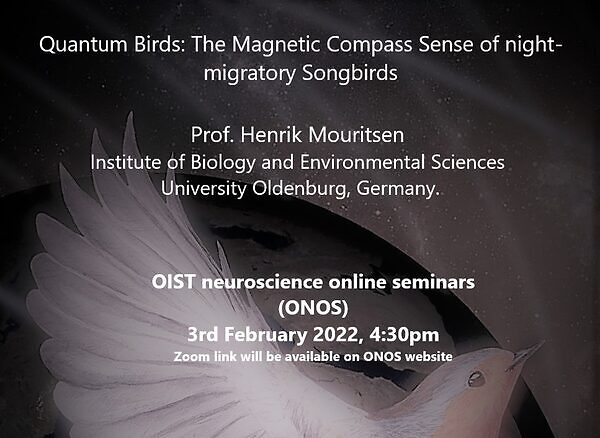Quantum Birds: The Magnetic Compass Sense of night-migratory Songbirds

Date
Location
Description
Quantum Birds: The Magnetic Compass Sense of night-migratory Songbirds
Prof. Henrik Mouritsen
Institute of Biology and Environmental Sciences, University Oldenburg,
Prof. Mouritsen will present how night-migratory songbirds seem to use a quantum mechanical mechanism to sense magnetic compass information which they use to navigate with exquisite precision over thousands of kilometres (Mouritsen 2018). In the past years, evidence has mounted that migratory birds use a light-dependent, radical pair-based mechanism to sense the axis of the geomagnetic field lines (Hore & Mouritsen 2016). The magnetic compass of night-migratory birds is sensitive to anthropogenic electromagnetic field disturbances being ca. 1000 times weaker than the current WHO guideline limits (Engels et al. 2014; Schwarze et al. 2016). This result could be significant in relation to migratory bird conservation measures and strongly indicates that the basic sensory mechanism underlying the magnetic compass of night-migratory songbirds should be based on quantum mechanical principles rather than classical physics. Neuroanatomical data have shown that magnetic compass information is detected in the eye and then processed in a small part of the thalamofugal visual pathway terminating in the visual processing centre “Cluster N” (Mouritsen et al. 2005; Liedvogel et al. 2007; Feenders et al. 2008; Zapka et al. 2009). When Cluster N is deactivated, migratory European Robins can no longer use their magnetic compass, whereas their star compass and sun compass abilities are unaffected (Zapka et al. 2009). The lagena and associated pathways remained intact. Bilateral section of the trigeminal nerve had no effect on the birds’ ability to use their magnetic compass (Zapka et al. 2009). Very recently, we could also show that the light-sensitive protein Cryptochrome 4 from a night-migratory songbird is magnetically sensitive in vitro based on a radical-pair mechanism (Xu et al. 2021).
Zoom link
https://oist.zoom.us/j/97850326939
Attachments
Subscribe to the OIST Calendar: Right-click to download, then open in your calendar application.



